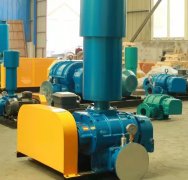The principle and advantages of dense Roots blower
The dense Roots blower is a gas compression and conveying equipment, and its principle and advantages are as follows:
1、 Principle
The working principle of a dense Roots blower is mainly based on the principle of a volumetric blower, which compresses and delivers gas through the relative motion of two blade rotors (usually three blade rotors) inside the cylinder. Specifically:
1. Rotor motion: Two three bladed rotors move relative to each other inside the cylinder, with gaps maintained between them and between them and the cylinder wall, without contact or friction.
2. Gas inhalation: When the rotor rotates, gas is sucked into the intake port of the cylinder. Due to the gap between the rotors and the sealing effect of the cylinder wall, the inhaled gas is effectively isolated in the intake chamber.
3. Gas compression: As the rotor continues to rotate, the gas in the intake chamber is gradually compressed and pushed towards the exhaust port. During this process, both the pressure and temperature of the gas will increase.
4. Gas discharge: When gas is compressed to a certain degree, it is pushed towards the exhaust port and discharged from the cylinder. Due to the reflux effect of high-pressure gas at the exhaust port, the gas will be further pressurized when discharged.
2、 Advantages
The dense Roots blower has multiple advantages, making it widely used in multiple industrial fields:
1. Compact structure: Compared with ordinary Roots blowers, dense Roots blowers have a more compact structure, occupying less space and space. This makes it more adaptable in situations where space is limited.
2. Energy saving: The intensive Roots blower adopts advanced design and manufacturing processes, resulting in higher operating efficiency and lower energy consumption. At the same time, it also has good sealing performance, reducing gas leakage and energy loss.
3. Smooth operation: Due to the clearance between rotors and the sealing effect of cylinder walls, the vibration and noise generated by the dense Roots blower during operation are relatively small. This makes it have better application prospects in situations where a quiet environment is required.
4. Easy maintenance: The structural design of the dense Roots blower is reasonable, making its maintenance and upkeep more convenient. For example, its intake and exhaust port structure adopts a spiral structure and is equipped with a muffler, making the intake and exhaust pulsation smooth, vibration small, and noise low; At the same time, its sealing structure is reasonable and oil and gas cannot enter the casing, so the output air is clean and free of grease.
5. Wide applicability: Dense Roots blowers can be applied in multiple fields, such as sewage treatment, aquaculture, pneumatic conveying, vacuum packaging, etc. It can be customized and selected according to different working conditions and requirements to meet various complex application scenarios.
In summary, intensive Roots blowers play an important role in multiple industrial fields with their unique principles and multiple advantages. During use, attention should be paid to its usage conditions and regular maintenance should be carried out to ensure its long-term stable operation.



